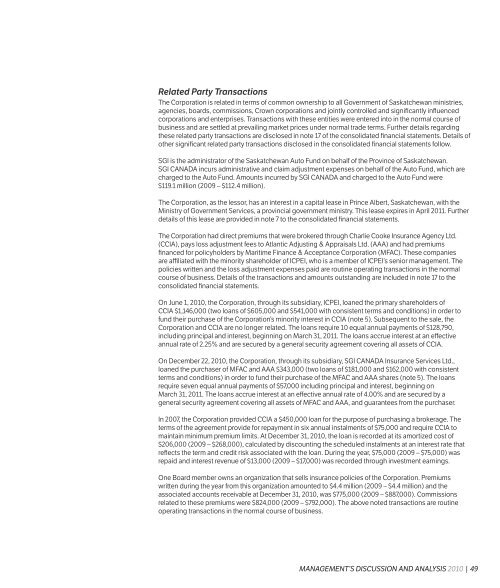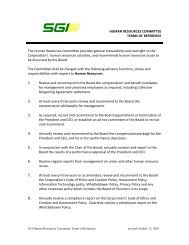Full report - SGI Canada
Full report - SGI Canada
Full report - SGI Canada
You also want an ePaper? Increase the reach of your titles
YUMPU automatically turns print PDFs into web optimized ePapers that Google loves.
National Policy 58-201 Corporate Governance Guidelines<br />
Guideline<br />
(c) the identification of the principal risks of<br />
the issuer’s business, and ensuring the<br />
implementation of appropriate systems to<br />
manage these risks;<br />
(d) succession planning (including appointing,<br />
training and monitoring senior<br />
management);<br />
(e) adopting a communication policy for the<br />
issuer;<br />
(f) the issuer’s internal control and<br />
management information systems; and<br />
(g) developing the issuer’s approach<br />
to corporate governance, including<br />
developing a set of corporate governance<br />
principles and guidelines that are<br />
specifically applicable to the issuer.<br />
The written mandate of the board should also<br />
set out:<br />
(i) measures for receiving feedback from<br />
stakeholders (e.g., the board may wish to<br />
establish a process to permit stakeholders<br />
to directly contact the independent<br />
directors), and<br />
(ii) expectations and responsibilities of<br />
directors, including basic duties and<br />
responsibilities with respect to attendance<br />
at board meetings and advance review<br />
of meeting materials. In developing<br />
an effective communication policy for<br />
the issuer, issuers should refer to the<br />
guidance set out in National Policy 51-201<br />
Disclosure Standards.<br />
Saskatchewan Government Insurance<br />
Yes. The Board of Directors undertakes a process<br />
to identify the principal risks of the business,<br />
to achieve a proper balance between risks<br />
incurred and potential returns, and to oversee<br />
the implementation of appropriate systems to<br />
manage the risks. The Board of Directors has<br />
established a Risk committee with responsibility<br />
for this function and it <strong>report</strong>s to the Board on<br />
those risks on at least an annual basis.<br />
Yes. The Board of Directors has charged the<br />
Human Resources committee with responsibility<br />
for reviewing the Corporation’s succession plan.<br />
The committee reviews the plan on an annual<br />
basis and <strong>report</strong>s its findings to the Board.<br />
Yes. The Corporation has a formal<br />
communications policy which has been<br />
approved by the Board of Directors.<br />
Yes.<br />
Yes.<br />
Yes. The Corporation also undertakes research<br />
annually on behalf of the Board.<br />
Yes. Position descriptions for directors were<br />
developed and approved.<br />
National Policy 58-201 Corporate Governance Guidelines<br />
Guideline<br />
Position Descriptions<br />
5. The board should develop clear position<br />
descriptions for the chair of the board<br />
and the chair of each board committee. In<br />
addition, the board, together with the CEO,<br />
should develop a clear position description<br />
for the CEO, which includes delineating<br />
management’s responsibilities. The board<br />
should also develop or approve the corporate<br />
goals and objectives that the CEO is<br />
responsible for meeting.<br />
Orientation and Continuing Education<br />
6. The board should ensure that all new directors<br />
receive a comprehensive orientation. All<br />
new directors should fully understand the<br />
role of the board and its committees, as well<br />
as the contribution individual directors are<br />
expected to make (including, in particular,<br />
the commitment of time and resources that<br />
the issuer expects from its directors). All new<br />
directors should also understand the nature<br />
and operation of the issuer’s business.<br />
7. The board should provide continuing<br />
education opportunities for all directors, so<br />
that individuals may maintain or enhance their<br />
skills and abilities as directors, as well as to<br />
ensure their knowledge and understanding of<br />
the issuer’s business remains current.<br />
Code of Business Conduct and Ethics<br />
8. The board should adopt a written code of<br />
business conduct and ethics (a code). The<br />
code should be applicable to directors,<br />
officers and employees of the issuer. The<br />
code should constitute written standards that<br />
are reasonably designed to promote integrity<br />
and to deter wrongdoing. In particular, it<br />
should address the following issues:<br />
(a) conflicts of interest, including transactions<br />
and agreements in respect of which a<br />
director or executive officer has a material<br />
interest;<br />
Saskatchewan Government Insurance<br />
Yes. Position descriptions for directors were<br />
developed and approved. A position description<br />
for the CEO has been developed and approved.<br />
The Board has developed and approved<br />
corporate goals and objectives.<br />
Yes. The Terms of Reference for the Board<br />
specify the responsibility for director training,<br />
which has been delegated to the Governance<br />
committee. New directors receive an orientation<br />
which provides an overview of the Corporation,<br />
its operations and its industry. Further, directors<br />
are educated on the role of the Board, its<br />
committees and the expectation of directors.<br />
The director position description describes a<br />
director’s responsibilities.<br />
Yes. The Board provides opportunities for all<br />
directors to increase their knowledge of issues<br />
and subjects facing the Corporation. Further,<br />
Crown Investments Corporation provides annual<br />
director training opportunities to all Crown<br />
corporation directors.<br />
Yes. The Board has adopted a written Code of<br />
Conduct for Directors and a Corporate Code<br />
of Ethics and Conduct which is applicible to<br />
directors, officers and employees.<br />
Yes. Conflicts of interest are addressed in both<br />
the Code of Conduct for Directors and the<br />
Corporate Code of Ethics and Conduct.<br />
(b) protection and proper use of corporate<br />
assets and opportunities;<br />
Yes. The protection and proper use of corporate<br />
assets and opportunities are addressed in<br />
both the Code of Conduct for Directors and the<br />
Corporate Code of Ethics and Conduct.<br />
98 | 2010 CORPORATE GOVERNANCE CORPORATE GOVERNANCE 2010 | 99















